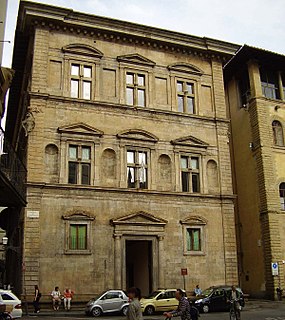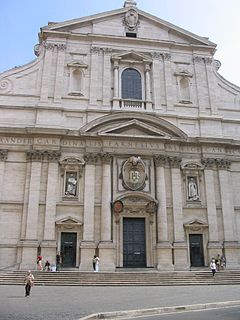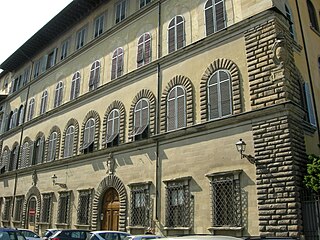This article needs additional citations for verification .(September 2018) (Learn how and when to remove this template message) |
The Palazzo Bartolini-Torrigiani is a palace located between Via Porta Rossa and Via delle Terme, in the city block just west of Piazza Santa Trinita that includes the Palazzo Bartolini Salimbeni, in the center of the city of Florence, region of Tuscany, Italy. This portion of the block includes the medieval Torre dei Monaldi, also known as della Rognosa, rising along Via Porta Rossa.

The Piazza Santa Trinita is a triangular square in Florence, Tuscany, Italy, named after the church of Santa Trinita on the west side of the square. The piazza is traversed by the Via de' Tornabuoni. Near the middle of the square is an ancient Roman column known as the Column of Justice due to the sculpture of "Justice" on the top. Several Gothic and Renaissance palaces surround the square, these include:

The Palazzo Bartolini Salimbeni is a High Renaissance-style palace located on Via de Tornabuoni on Piazza Trinita in central Florence, Tuscany, Italy.

Florence is the capital city of the Italian region of Tuscany. It is the most populous city in Tuscany, with 383,084 inhabitants in 2013, and over 1,520,000 in its metropolitan area.

Buildings here had been present since the 13th century, owned by the Spini and Scali families. By 1369, the property around the tower, named for the Monaldi family, became property of Costanza del Mula Soldanieri, wife of Neri di Lapo, nel 1369. An inn, known as the Albergho di Porta Rossa or Locanda del Cammello was located here in 1386. In 1477, Bartolomeo Bartolini bought these buildings, including the tower. [1]

The Bartolini had owned property in this sector since 1348. They progressively extended their holdings till by the 16th century they owned nearly the entire city block. The best known construction for the family here was the palace on Piazza Santa Trinita. [2]
By the mid-16th century, the property here was sold to the Dati, then in 1559 to the Torrigiani, whose descendants still own the property, now occupied by the Hotel Porta Rossa. The building has undergone various refurbishments and reconstructions over the centuries.
Coordinates: 43°46′12.26″N11°15′14.00″E / 43.7700722°N 11.2538889°E

A geographic coordinate system is a coordinate system that enables every location on Earth to be specified by a set of numbers, letters or symbols. The coordinates are often chosen such that one of the numbers represents a vertical position and two or three of the numbers represent a horizontal position; alternatively, a geographic position may be expressed in a combined three-dimensional Cartesian vector. A common choice of coordinates is latitude, longitude and elevation. To specify a location on a plane requires a map projection.













